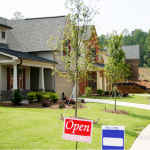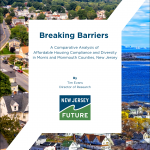New Jersey Future Blog
The Risk to Our Roofs: Considering and Harnessing the Climate-Housing Nexus
July 11th, 2022 by Michael Atkins
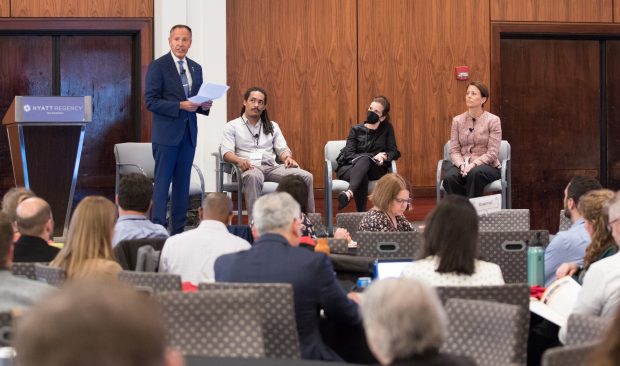
Plenary session “The Risk to Our Roofs: Considering and Harnessing the Climate-Housing Nexus” during the New Jersey Future and APA-NJ New Jersey Planning and Redevelopment Conference 2022 at the Hyatt Regency, New Brunswick on June 16, 2022. Photo Credit: Keith Muccilli
New Jersey faces major challenges with the dual threat of climate change and housing unaffordability. While at face value, these two issues seem to pertain to natural or built environments, respectively, the two are inseparably linked and must be addressed in tandem.
At the 2022 NJ Planning and Redevelopment Conference, co-hosted by New Jersey Future and the American Planning Association New Jersey Chapter (APA-NJ), the intersection of housing and the environment was given center stage during the lunch plenary session. This session featured a row of experts in this field, moderated by Thomas Dallessio, Vice President of Policy, APA-NJ.
As the experts enumerated, the idea of forming “resilient cities” is aimed at providing protections for residents and erecting environmental buffers to protect the people housed in climate vulnerable communities. As opening panelist Dana Bourland, senior vice president at the JPB Foundation, outlined, “gray” communities—or the existing impermeable hardscape and car-centric design of many buildings, commercial corridors, and communities—exacerbate inequalities that overburden people of low-income and Black and Brown communities.
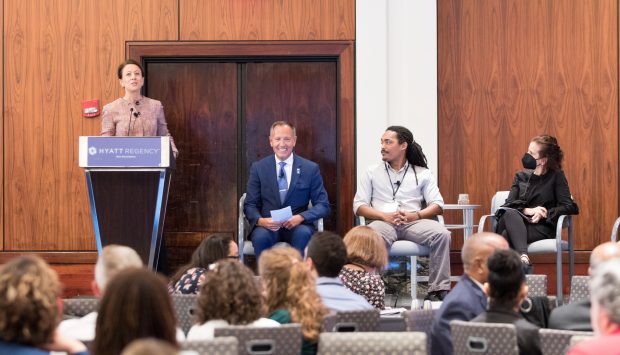
Dana Bourland speaking at New Jersey Planning and Redevelopment Conference 2022. Photo Credit: Keith Muccilli
“Green” developments seek to capitalize upon climate resiliency and carbon sequestration by utilizing recycled materials, alternative energy sources (i.e. solar roofing), and integrative design into the fabric of the community. Through integrative design, low-income and eldery residents can more easily live car-free or conveniently utilize multimodal transportation options that encourage public health and reduce carbon transportation emissions. Bourland is the author of “From Gray to Green: A Call to Action on the Housing and Climate Crises”, a book on this subject recommended to all audience members and readers, and has also developed a publicly available toolkit, “The Green Communities Criteria,” which is available online at greencommunitiesonline.org.
Georgeen Theodore—professor at Hillier College of Architecture and Design of the New Jersey Institute of Technology—shared a rich presentation that explored best practices in design and redevelopment to foster physical resilience from storms and flooding, focusing on housing development and environmental landscaping in coastal communities. Theodore sought to illustrate techniques to move residents from low-lying flood prone areas to higher ground, by both constructing new resilient housing and providing floodplain buy back funding for existing residents to assist their move. She also highlighted that floodplain reclamation presents an occasion to develop grassy wetland areas that can serve not only as a buffer between the bay and housing in a storm, but provide access to open space and recreational opportunities for residents through all seasons.
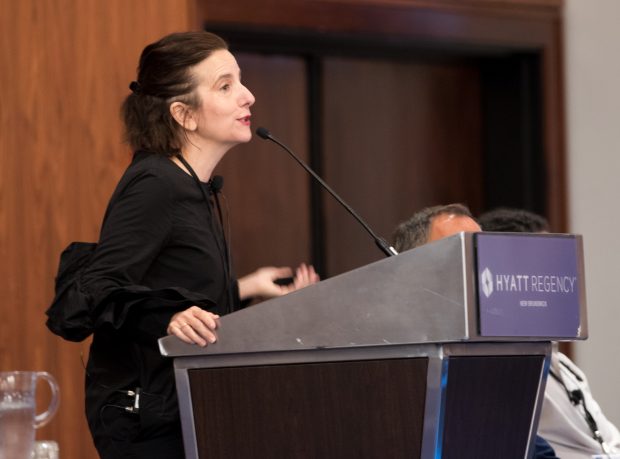
Georgeen Theodore speaking at New Jersey Planning and Redevelopment Conference 2022. Photo Credit: Keith Muccilli
Kelvin Broddy grounded the entire conversation with real-life, firsthand experiences by sharing his perspective of flooding and housing in Newark. Boddy is director of Healthy Homes and Communities, Housing and Community Development Network of New Jersey (HCDNNJ), a statewide membership-based organization with over 270 members including foundations, businesses, community development corporations,and private developers. Together, members work to construct affordable housing that is “healthy in both construction and location.” Affordable housing is too often constructed in undesirable and precarious land, or cordoned off into one section of a city or town. These development patterns leave residents of affordable housing–-who are low-income and/or of Black and Brown communities—vulnerable to not only floods, but extreme heat and poor air quality.
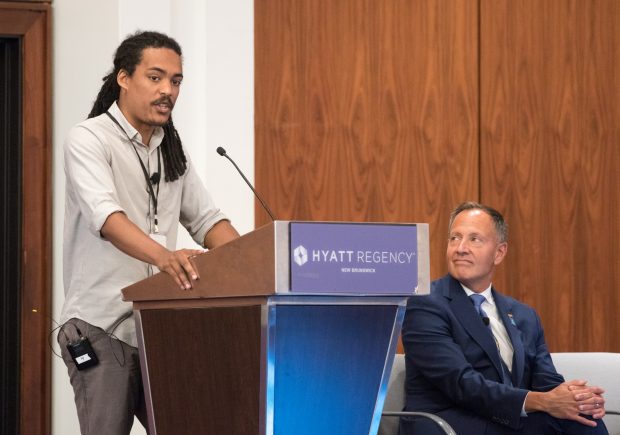
Kelvin Broddy speaking at New Jersey Planning and Redevelopment Conference 2022. Photo Credit: Keith Muccilli
In the past decade, Superstorm Sandy (2012) and Hurricane Ida (2021) expose the vulnerability of affordable housing units in Northern New Jersey, and the rate we can expect extreme weather events to continue to occur. Boddy pointed to examples in Newark, Elizabeth, and Penns Grove to illustrate the placement of affordable housing in flood-prone areas, or along tributaries that stand to flood regularly in the century ahead.
Not all hope is lost, as Boddy issued a series of solutions proven to address the issue of affordable housing vulnerability to flooding associated with climate change. Primarily, new public and affordable housing should be developed without residences on the ground floor. Existing affordable housing must be preserved, and in some cases restorated, so that cities and towns do not lose their affordable housing stock in the wake of an extreme weather event. Finally, tree plantings and green space improvements in existing and future affordable housing complexes can cool temperatures and improve air quality. Boddy concluded, “With an influx of money from both state and federal governments for the development of affordable housing, it is more important than ever that we ensure both new and old development can meet any challenges the state’s climate presents.”
Related Posts
Tags: Affordable housing, climate change, coastal flooding, communities, flooding, Housing, resilient cities

